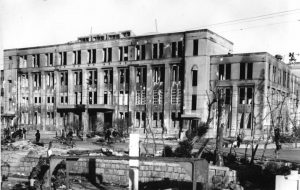Documenting Hiroshima of 1946: January 9, Hiroshima City newly establishes reconstruction division
Jan. 9, 2025
by Kyosuke Mizukawa, Senior Staff Writer
On January 9, 1946, the Hiroshima City government announced personnel appointments for its newly established reconstruction division, which was to become the main city agency responsible for city planning and other matters. Satoshi Nagashima, who had served as head of the city planning division for the Gifu Prefectural government, was appointed to lead the division on the recommendation of Japan’s Home Ministry.
Shinso Hamai, who was involved in the launch of the division, had only just assumed the post of deputy mayor of Hiroshima in December 1945. Mr. Hamai wrote in his 1967 book titled Genbaku Shicho (in English, ‘A-bomb mayor’), “At the time I was at a loss as to where to begin. There were countless things to be done,” with information hereinafter quoted from the same publication. He first worked on reconstruction of the division, indicating that, “If we don’t do that, we won’t get any work done.”
Many city employees were also killed in the atomic bombing by the U.S. military. Mr. Hamai thought, “The number of staff members has decreased, and efficiency won’t improve with only lots of managers,” and he thus advised Hiroshima City Mayor Shichiro Kihara to abolish the existing departments and have each unit report directly to the mayor. Mr. Hamai also placed ads in newspapers seeking information about missing employees and reluctantly classified them as being ‘resigned’ if no contact had been made after a certain period of time.
City planning, work that was tasked to the reconstruction division, was indispensable to the lives of citizens. The Chugoku Shimbun newspaper dated February 20, 1946, pointed out that, “One of the obstacles to construction of housing was that city planning has not been finalized.” The article reasoned that was because rezoning and land-use policies were closely connected to the locations where housing was to be built.
Hiroshima City also established a reconstruction council to reflect the opinions of citizens in the process of city planning, with representatives of local business communities and the heads of neighborhood associations appointed to serve as council members. The council’s first meeting was held at Hiroshima City Hall on February 25.
Mr. Hamai also served as a committee member. He said what motivated him was the sight of corrugated iron shacks visible from his deputy mayor’s office in City Hall standing here and there amid the incinerated ruins. He wrote, “Looking at those shacks every day, I thought people there were living in misery, which whipped up my sometimes flagging spirit.”
(Originally published on January 9, 2025)
On January 9, 1946, the Hiroshima City government announced personnel appointments for its newly established reconstruction division, which was to become the main city agency responsible for city planning and other matters. Satoshi Nagashima, who had served as head of the city planning division for the Gifu Prefectural government, was appointed to lead the division on the recommendation of Japan’s Home Ministry.
Shinso Hamai, who was involved in the launch of the division, had only just assumed the post of deputy mayor of Hiroshima in December 1945. Mr. Hamai wrote in his 1967 book titled Genbaku Shicho (in English, ‘A-bomb mayor’), “At the time I was at a loss as to where to begin. There were countless things to be done,” with information hereinafter quoted from the same publication. He first worked on reconstruction of the division, indicating that, “If we don’t do that, we won’t get any work done.”
Many city employees were also killed in the atomic bombing by the U.S. military. Mr. Hamai thought, “The number of staff members has decreased, and efficiency won’t improve with only lots of managers,” and he thus advised Hiroshima City Mayor Shichiro Kihara to abolish the existing departments and have each unit report directly to the mayor. Mr. Hamai also placed ads in newspapers seeking information about missing employees and reluctantly classified them as being ‘resigned’ if no contact had been made after a certain period of time.
City planning, work that was tasked to the reconstruction division, was indispensable to the lives of citizens. The Chugoku Shimbun newspaper dated February 20, 1946, pointed out that, “One of the obstacles to construction of housing was that city planning has not been finalized.” The article reasoned that was because rezoning and land-use policies were closely connected to the locations where housing was to be built.
Hiroshima City also established a reconstruction council to reflect the opinions of citizens in the process of city planning, with representatives of local business communities and the heads of neighborhood associations appointed to serve as council members. The council’s first meeting was held at Hiroshima City Hall on February 25.
Mr. Hamai also served as a committee member. He said what motivated him was the sight of corrugated iron shacks visible from his deputy mayor’s office in City Hall standing here and there amid the incinerated ruins. He wrote, “Looking at those shacks every day, I thought people there were living in misery, which whipped up my sometimes flagging spirit.”
(Originally published on January 9, 2025)








